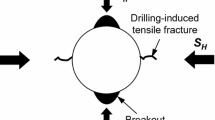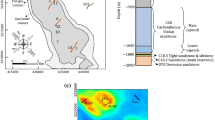Abstract
It is essential to understand the in situ stresses underground for engineering design and ground stability control in mining, geotechnical and petroleum engineering. Determination of the complete 3D stresses is particularly difficult due to the complex conditions underground. Overcoring and some other methods have been used in the past. They are either very expensive to implement or are based on some pre-assumptions. A recently developed alternative method is based on differential-direction drilling (D3 method). By this method, the complete 3D in situ stresses can be estimated through measurements of diametrical borehole deformation in multiple non-parallel planes. The D3 method has overcome the theoretical hurdle of using 2D data to find a 3D solution to the in situ stresses. It has five mathematical models to fit the anticipated field conditions. This paper, as a follow-up, considers practical applications of the D3 method and analyzes a few key factors which may affect its application. The minimum space angle between measurement planes and the minimum number of measurement directions in each plane (or around a borehole) are determined. The effects of measurement errors and selection of a proper model for a specific site condition are also analyzed. A statistical approach is applied to help detect erroneous measurement data and search for the best-fit solution. Practical drilling patterns in mining and petroleum engineering are also suggested.















Similar content being viewed by others
Data availability
All data generated and analyzed during this study are included in this manuscript.
References
Amadei B, Stephansson O (1997) Rock stress and its measurement. Chapman and Hall, London
Barnet V, Lewis T (1978) Outlier in statistic data. Wiley, New York
Chen GZ, Chenevert ME, Sharma MM, Yu MJ (2003) A study of wellbore stability in shales including poroelastic, chemical, and thermal effects. J Petrol Sci Eng 38:167–176. https://doi.org/10.1016/S0920-4105(03)00030-5
Cornet FH, Valette B (1984) In-situ stress determination from hydraulic injection test data. J Geophys Res 89:11527–11537. https://doi.org/10.1016/B978-0-08-042066-0.50022-7
Fjær E, Holt RM, Horsrud P, Raaen AM, Risnes R (2021) Petroleum related rock mechanics, 3rd edn. Elsevier, Amsterdam
Ghassemi G, Tao Q, Diek A (2009) Influence of coupled chemo-poro-thermoelastic processes on pore pressure and stress distributions around a wellbore in swelling shale. J Petrol Sci Eng 67:57–64. https://doi.org/10.1016/j.petrol.2009.02.015
Guglielmi Y, Cappa F, Lancon H, Janowczyk JB, Rutqvist J, Tsang CF, Wang JSY (2014) ISRM suggested method for step-rate injection method for fracture in-situ properties (SIMFIP): using a 3-components borehole deformation sensor. Rock Mech Rock Eng 47:303–311. https://doi.org/10.1007/s00603-013-0517-1
Hines WW, Montgomery DC (1990) Probability and statistics in engineering and management science. Wiley, Toronto
Lin C (2019) Estimation of 2D and 3D in-situ stresses using back analysis of measurements of borehole/well deformation. Dissertation, Dalhousie University
Lin C, Zou DH (2021) Formulation and verification of 3D in-situ stress estimation based on differential-direction drilling. Int J Rock Mech Min Sci 145:104833. https://doi.org/10.1016/j.ijrmms.2021.104833
Lin C, Zou DH, Sun HR (2019) Exploration of measurement methods of 3D in-situ stresses in rock masses. Int J Georesour Environ 5:1–13. https://doi.org/10.15273/ijge.2019.01.001
Lund RE (1975) Tables for an approximate test for outliers in linear models. Technometrics 17:473–476. https://doi.org/10.2307/1268434
Pfaffenberger RC, Patterson JH (1977) Statistical methods for business and economics. Richard D. Irwin Inc., Homewood
Shi C, Lin B, Yu H, Shi SZ, Zhang JH (2023) Characterization of hydraulic fracture configuration based on complex in situ stress field of a tight oil reservoir in Junggar Basin, Northwest China. Acta Geotech 18:757–775. https://doi.org/10.1007/s11440-022-01607-4
Synn JH, Park C, Jung YB, Sunwoo C, Kim KS, Choi SY, Song MK, Shin IJ, Rutqvist J (2015) Integrated 3-D stress determination by hydraulic fracturing in multiple inclined boreholes beneath an underground cavern. Int J Rock Mech Min Sci 75:44–55. https://doi.org/10.1016/j.ijrmms.2015.01.012
Vreede FA (1981) Critical study of the method of calculating virgin rock stresses from measurement results of the CSIR triaxial strain cell. Research report, Pretoria, South Africa
Zou DH (1995) Statistical regression applied to borehole strain measurements data analysis. Geotech Geol Eng 13:17–27. https://doi.org/10.1007/BF00600521
Zou DH (2020) Applied rock mechanics and ground stability, 2nd edn. Canamaple Academia Services, Halifax
Acknowledgements
The authors are grateful to those scholars who provided valuable suggestions and comments on this research.
Author information
Authors and Affiliations
Contributions
All authors participated in the design and implementation of the study and contributed to the analysis and discussion of results and the writing of the manuscript.
Corresponding author
Ethics declarations
Conflict of interest
The authors have no competing interests to declare that are relevant to the work reported in this paper.
Additional information
Publisher's Note
Springer Nature remains neutral with regard to jurisdictional claims in published maps and institutional affiliations.
Rights and permissions
Springer Nature or its licensor (e.g. a society or other partner) holds exclusive rights to this article under a publishing agreement with the author(s) or other rightsholder(s); author self-archiving of the accepted manuscript version of this article is solely governed by the terms of such publishing agreement and applicable law.
About this article
Cite this article
Zou, D.H.S., Lin, C. Practical considerations for the complete 3D in situ stress estimation from convergence data using the D3 method. Acta Geotech. 19, 1063–1081 (2024). https://doi.org/10.1007/s11440-023-01919-z
Received:
Accepted:
Published:
Issue Date:
DOI: https://doi.org/10.1007/s11440-023-01919-z




